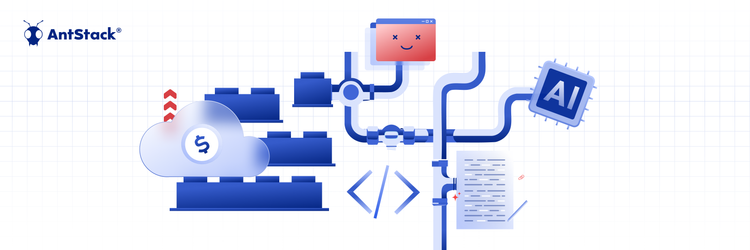Serverless, a Catalyst for Organizational Agility, Not Just Cost Optimization
The software development sector is ever-changing. According to statistics, there will be almost 28.7 million developers across the globe by the end of 2024. Technological advancements make it easy to write codes and distribute different products.
It is important to choose the proper software architecture to handle the pressing needs of businesses of various sizes to create more agility and flexibility, test and develop different innovative technology solutions, expand into various markets, reduce operating expenses, and optimize and combine various revenue resources. As you read this article, you can understand the differences between the serverless vs monolith architecture:
What is a monolithic application?
The monolithic app happens to be an all-in-one application. It is equipped with different features within a singular codebase, which is written in the technology stack and singular programming language. Take an instance where you want to create an online store to sell t-shirts. You need an app to manage inventory, payments, checkouts, and updates to orders.
It is easy to build and deploy monolithic apps as they are composed of fewer components than microservices. Such simplicity involves the cost of different complicated interactions between different components, owing to which it becomes challenging to scale them according to business growth and changing business requirements.
You need to remember that monolithic apps are not a bad thing. It can be an ideal choice for simple apps. During the earlier phases of software development, microservices were used. Monolithic machines were used to run a single task at once.
If the app is equipped with an ample amount of data related to every user record and you are executing different performance problems with massive databases, you should make sure to break the user records into different separate entities. Monolithics can be a good choice for some apps. However, if you want to go for complex systems, you should choose microservices.
Pros
The cross-cutting problems need to be handled only once. For instance, you should set up the data source connection pool, select and configure the Tomcat parameters, handle exceptions, logging, security, and monitoring. The app does not have any restrictions from a logical standpoint. If you need specific data for the latest functionality, the monolithic app is a good choice. Every location has a different source code.
The latest team members became familiar with the app, thereby debugging the specific functional flow. As the code is present in a singular location, debugging becomes easy. Finding a problem, followed by the request flow, becomes simple. It is important to deploy the deployment unit. There is no dependence.
As the user interface gets packed with backend code, it does not involve breaking changes. As the app becomes successful, the monolithic architecture problems start to appear. The app growth is recognized as the straight-forward reason for this.
What is a serverless architecture?
The app executes on a server, which is not managed by you. You can execute and create the services and apps through the serverless architecture without the need to manage the infrastructure. Though the app operates on different servers, the cloud service provider is responsible for handling the server administration. If you want to execute databases, apps, and storage systems, you should scale, provision, and maintain different servers.
The users interface with the apps, thereby accessing the business logic through servers. Server administration needs a certain amount of resources and time. So, the team should keep up with security and software updates, server hardware maintenance, and backup creation. The developers will focus on app creation by offloading such duties to a third-party supplier through the application of serverless architecture.
Serverless app architecture has been gaining popularity for almost a decade. It introduced the FaaS platform to the mainstream. A wide assortment of developers are using AWS Lambda to create serverless apps. However, certain business enterprises are using their FaaS offerings.
Benefits of choosing a serverless architecture
By choosing a serverless architecture, the engineers can launch the code easily without the need to handle the servers. It boosts delivery times, thereby providing a suitable choice for businesses to facilitate business growth. Within the concurrency constraints, the instances are withdrawn or added automatically in response to traffic fluctuations.
Now, we are going to talk about the differences between monolithic and serverless architectures. Kindly check it out!
Adaptability and flexibility
The monolithic and serverless architectures offer different degrees of flexibility. Such solutions accommodate different updates and changes. The serverless architecture is adaptable and flexible. It is evident in specific individual functions and microservices.
The developers can update specific parts of the application without changing the entire app. The monolithic app comes with specific restrictions on flexibility. If you are introducing specific changes in a part of the system, such changes affect the whole application.
Performance
Serverless walks the extra mile as it offers the best opportunity for the individual processes to scale according to the demands. As the workloads try to migrate, you will be able to send more requests to serverless systems, thereby triggering the necessary functions. Response times are extremely fast for the active functions. However, it involves latency, or a cold start, which appears after the inactivity.
Monolithic architecture scales completely. As such, scaling is completely managed and predictable, so you might have unused computing resources during non-peak periods. Such architecture experiences faster response times and reduced latency as the components are integrated tightly.
Cost considerations
Costs happen to be an important consideration when speaking of the differences between serverless and monolith architectures. Serverless architecture involves paying only for the functions and resources you are using. You do not need to spend extra money on infrastructure maintenance. You can leverage the resources wisely, thereby scaling during traffic hikes and peak periods.
On the other hand, when it comes to the financial considerations of the monolith architecture, you should allocate various costs to create the infrastructure. Choosing the monolith architecture involves covering different maintenance expenses. You need to incur additional costs as necessary for scaling.
Let’s sum up the differences between the monolith architecture and the serverless architecture. Check it out!
The serverless consulting offers easy on-demand scaling, whereas the monolithic model requires significant effort for expansion. The serverless architecture is known to be highly flexible, whereas the monolithic architecture provides the option for simpler testing and development. Monolithic provides easier testing and debugging than the serverless architecture.
The third-party vendors maintain the serverless systems, whereas the monolithic architecture demands manual updates. The serverless architecture works on pay-per-use pricing, whereas the monolithic architecture completely depends on resources.
Should you choose between monolithic architecture and serverless architecture?
You should determine the requirements before you decide on the architecture. You should pick serverless if you are trying to deal with massive projects and move to workouts. On the other hand, you should move to a monolithic architecture if the project needs simpler infrastructure. The monolith is easy to operate and fits the smaller teams perfectly. Serverless is the perfect option if you are looking for event-driven architecture and distributed systems.
If the project demands frequent updates and greater flexibility, you should choose serverless. However, you should go for monolith if you want to deal with different predictable workloads. Speaking of budget constraints, you need to determine the amount you can spend on the software architecture. Serverless architecture happens to be an affordable choice. However, if you want to go for small-scale projects, monolith is the most reasonable option.









